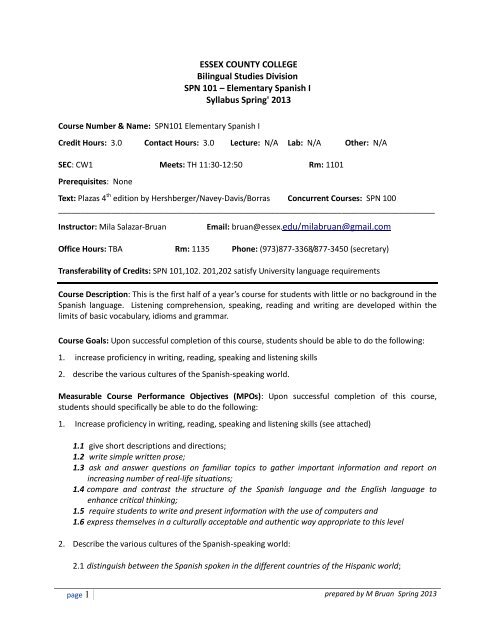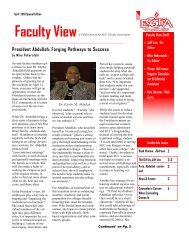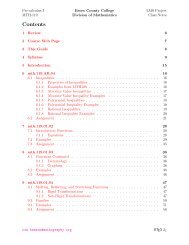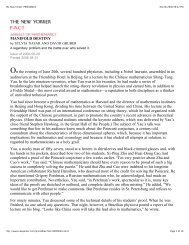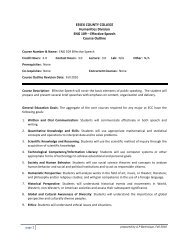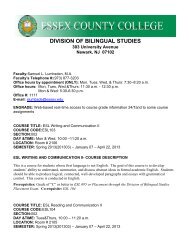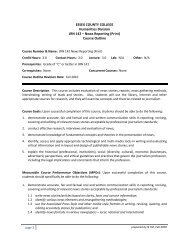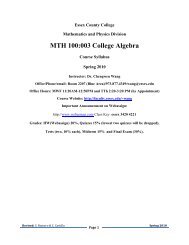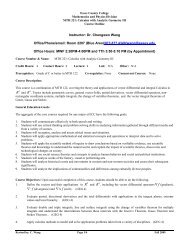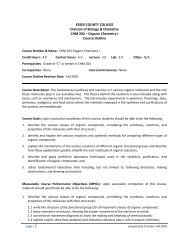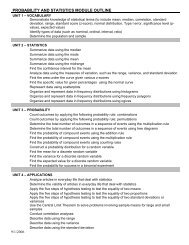Syllabus - Essex County College Faculty Web Server
Syllabus - Essex County College Faculty Web Server
Syllabus - Essex County College Faculty Web Server
Create successful ePaper yourself
Turn your PDF publications into a flip-book with our unique Google optimized e-Paper software.
ESSEX COUNTY COLLEGE<br />
Bilingual Studies Division<br />
SPN 101 – Elementary Spanish I<br />
<strong>Syllabus</strong> Spring' 2013<br />
Course Number & Name: SPN101 Elementary Spanish I<br />
Credit Hours: 3.0 Contact Hours: 3.0 Lecture: N/A Lab: N/A Other: N/A<br />
SEC: CW1 Meets: TH 11:30-12:50 Rm: 1101<br />
Prerequisites: None<br />
Text: Plazas 4 th edition by Hershberger/Navey-Davis/Borras Concurrent Courses: SPN 100<br />
_____________________________________________________________________________________<br />
Instructor: Mila Salazar-Bruan<br />
Email: bruan@essex.edu/milabruan@gmail.com<br />
Office Hours: TBA Rm: 1135 Phone: (973)877-3368/877-3450 (secretary)<br />
Transferability of Credits: SPN 101,102. 201,202 satisfy University language requirements<br />
Course Description: This is the first half of a year’s course for students with little or no background in the<br />
Spanish language. Listening comprehension, speaking, reading and writing are developed within the<br />
limits of basic vocabulary, idioms and grammar.<br />
Course Goals: Upon successful completion of this course, students should be able to do the following:<br />
1. increase proficiency in writing, reading, speaking and listening skills<br />
2. describe the various cultures of the Spanish-speaking world.<br />
Measurable Course Performance Objectives (MPOs): Upon successful completion of this course,<br />
students should specifically be able to do the following:<br />
1. Increase proficiency in writing, reading, speaking and listening skills (see attached)<br />
1.1 give short descriptions and directions;<br />
1.2 write simple written prose;<br />
1.3 ask and answer questions on familiar topics to gather important information and report on<br />
increasing number of real-life situations;<br />
1.4 compare and contrast the structure of the Spanish language and the English language to<br />
enhance critical thinking;<br />
1.5 require students to write and present information with the use of computers and<br />
1.6 express themselves in a culturally acceptable and authentic way appropriate to this level<br />
2. Describe the various cultures of the Spanish-speaking world:<br />
2.1 distinguish between the Spanish spoken in the different countries of the Hispanic world;<br />
page 1 prepared by M Bruan Spring 2013
2.2 recognize and describe the rich, vast culture and civilization of the Hispanic world;<br />
2.3 discuss the influences of the Hispanic culture on the American society; and<br />
2.4 describe the various schedules in the Hispanic world<br />
Methods of Instruction: Language use is encouraged through communicative activities including videos,<br />
compact discs (CDs), Spanish language computer software, on-line study center, group work, use of<br />
appropriate Spanish websites, role-playing, games, reading assignments from the text and other sources,<br />
current events, class lectures, discussions and cultural trips.<br />
Outcomes Assessment: Written exams and topics for oral presentations are blueprinted to course<br />
objectives and evaluated via checklist rubrics. Data is collected and analyzed to determine the level of<br />
student performance on these assessment instruments in regards to meeting course objectives. The<br />
results of this data analysis are used to guide necessary pedagogical and/or curricular revisions<br />
Course Requirements: All students are required to:<br />
1. Three written tests on the material presented in each chapter of the textbook and four to six short<br />
quizzes. Each test will include reading and listening comprehension, grammar, and vocabulary.<br />
2. Familiarity with the minimum of grammatical forms contained in the textbook.<br />
3. Ability to use and spell all words and idioms covered during the semester.<br />
4. Paraphrase basic Spanish sentences using the verbs in context in a sentence.<br />
5. Active participation in classroom activities designed to enhance conversational fluency.<br />
6. Weekly homework assignments from the textbook or other sources.<br />
7. Class attendance (at least 90% of class sessions)<br />
8. Final comprehensive exam. It may include oral and written components.<br />
Methods of Evaluation:<br />
Students must demonstrate 70% proficiency on chapter tests, and homework assignments and<br />
final exams. Students must be ready to participate actively in all group, whole class activities and<br />
cultural trips.<br />
Students must demonstrate 70% competency on chapter tests and homework assignments and<br />
final exam. Students mu Final course grades will be computed as follows:<br />
% of<br />
Grading Components<br />
final course grade<br />
Chapter tests and quizzes 30%<br />
Students must attend 90% of all classes and participate in<br />
all class activities, which are designed to emphasize course<br />
objectives.<br />
page 2 prepared by M Bruan Spring 2013
Homework 20%<br />
Students complete homework, which is evaluated to<br />
ensure that they are meeting course objectives.<br />
Class attendance and participation in group and whole class activities 20%<br />
Written and oral tests scored by checklist rubrics will<br />
provide evidence of the extent to which students master<br />
course objectives.<br />
Final exam (Written and Oral) 30%<br />
Written exams will provide evidence of the extent to<br />
which students master course objectives and have<br />
synthesized all course material.<br />
NOTE: Students must demonstrate 70% competency on chapter tests and homework assignments and<br />
final exam. Students must be ready to participate actively in all group and whole class activities.<br />
Academic Integrity: Dishonesty disrupts the search for truth that is inherent in the learning process and<br />
so devalues the purpose and the mission of the <strong>College</strong>. Academic dishonesty includes, but is not limited<br />
to, the following:<br />
<br />
<br />
<br />
<br />
plagiarism – the failure to acknowledge another writer’s words or ideas or to give proper credit<br />
to sources of information;<br />
cheating – knowingly obtaining or giving unauthorized information on any test/exam or any<br />
other academic assignment;<br />
interference – any interruption of the academic process that prevents others from the proper<br />
engagement in learning or teaching; and<br />
fraud – any act or instance of willful deceit or trickery.<br />
Violations of academic integrity will be dealt with by imposing appropriate sanctions. Sanctions for acts<br />
of academic dishonesty could include the resubmission of an assignment, failure of the test/exam, failure<br />
in the course, probation, suspension from the <strong>College</strong>, and even expulsion from the <strong>College</strong>.<br />
Student Code of Conduct: All students are expected to conduct themselves as responsible and<br />
considerate adults who respect the rights of others. Disruptive behavior will not be tolerated. All<br />
students are also expected to attend and be on time for all class meetings. No cell phones or similar<br />
electronic devices are permitted in class. Please refer to the <strong>Essex</strong> <strong>County</strong> <strong>College</strong> student handbook,<br />
Lifeline, for more specific information about the <strong>College</strong>’s Code of Conduct and attendance<br />
requirements.<br />
page 3 prepared by M Bruan Spring 2013
Course Content Outline: based on the text Plazas 4th edition, by Hershberger/Navey-Davis/Borrás A.<br />
published by Heinle/Cengage Learning<br />
Week<br />
Content<br />
1 Introduction and explanation of class syllabus<br />
Conversación; “Mucho Gusto”<br />
Greet others, introduce yourself and say good-bye. Exchange personal<br />
information(name, origin, address, etc. Numbers 0 – 30, interrogative words, subject<br />
pronouns,, present tense of verb “ser”, verb form of “hay” and question and answer<br />
words.<br />
Unit 1, Capítulo Preliminar 1<br />
Cultural Information<br />
Simon Bolivar,<br />
La Alhambra, España,<br />
Teotihuacán México<br />
Plaza de la Independencia, Ecuador.<br />
Los Indígenas Kuna,<br />
“Mami Me Gusta” by Todos Estrellas<br />
2 Conversación: “ En Una Clase de Español en los Estados Unidos”<br />
Identify people and things in the classroom, indicate relationships, specify colors,<br />
describe everyday activities, talk about academic courses, university buildings, tell time<br />
and days of the week, definite and indefinite articles and gender.<br />
Unit 1, Capítulo I<br />
Cultural Information<br />
Jaime Escalante<br />
Misión de San Javier de Bac,<br />
3 Conversación: :”En Una Reunión Familiar en Méjico”<br />
How to make plural nouns and present tense conjugation of “ar” verbs and<br />
review<br />
Unit 1, Capítulo 1<br />
Cultural Information<br />
La Escuela de Madera<br />
San Agustin, Florida,<br />
El dominó,<br />
The Alameda, San Antonio,Texas<br />
“Cumbia de los Muertos” by Ozomatli<br />
Quizz<br />
4 Define and ask about family relationships, indicate ownership and possession, describe<br />
people and things, nationalies, numbers 30 – 100, possession with “de, del”, uses of the<br />
verb “ser”, agreement with descriptive adjectives,<br />
Unit 2, Capítulo 2<br />
page 4 prepared by M Bruan Spring 2013
Cultural Information<br />
Felipe, Calderon,<br />
La Civilización Maya<br />
Las Playas de México<br />
La Virgen de Guadalupe,<br />
5 Present tense conjugation of “er” and “ir” verbs and common uses of verb<br />
“tener”<br />
Unit 2 Capítulo 2<br />
Cultural Information<br />
Frida Kahlo y Diego Rivera,<br />
“Labios Compartidos” by Maná,<br />
“A Leer” :Una Celebración de Quinceañera<br />
Review and Written Test I<br />
Week<br />
Content<br />
6 Conversación: El Tiempo Libre Colombia<br />
Express likes and dislikes, describe basic actions, places, and activities in town,<br />
leisure time activities and verb “gustar”,<br />
Unit 3 Capítulo 3 A<br />
Cultural Information:<br />
Actores y Actrices colombianos,<br />
El Parque Nacional de Tayrona and<br />
El Carnaval de Barranquilla<br />
7 Verbs “ ir +a”, some irregular yo verbs. Review<br />
Unit 3 Capítulo 3 B<br />
Cultural Information:<br />
Cantantes y Músicos colombianos,<br />
Fernando Botero,<br />
Written Test II<br />
8 More Irregular yo verbs, saber and conocer. Review<br />
Unit 3 Capítulo 3 C<br />
Cultural Information<br />
“Fijate Bien” by Juanes<br />
¡A Leer! Guia Turística de Bogotá<br />
9 Conversación; “En la Casa: España, review<br />
Describe your home or personal residence, talk about furniture, appliances and<br />
describe household chores, make commands, present progressive verbs, numbers 100<br />
and above<br />
page 5 prepared by M Bruan Spring 2013
Unit 4 Capítulo 4 A<br />
Cultural Information<br />
Antonio Gaudi,<br />
La Iglesia de Vera Cruz,<br />
El Palacio de la Zarzuela<br />
Quizz<br />
10 Present tense of stem-changing verbs “e” to “ie”, “o” to “ue”, “e” to “i”. more<br />
idioms of the verb “tener”<br />
Unit 4 Capítulo 4 B<br />
Cultural Information<br />
Las Tapas<br />
El Museo del Prado,<br />
11 Affirmative tu commands, the verb “estar”, review<br />
Unit 4 Capítulo 4 C<br />
Cultural Information<br />
Museo Nacional Centro de Reina Sofía<br />
Bulería by David Bisbal<br />
Written test III<br />
12 Conversación: Bolivia y Paraguay, review<br />
Identify parts of the body, daily routine, hygiene practices, describe people,<br />
things and conditions, reflexive verbs<br />
Unit 5 Capítulo 5 A<br />
Cultural Information<br />
Operación Sonrisa<br />
Las Cataratas de Iguazú<br />
Quizz<br />
Week<br />
Content<br />
13 Verbs “acabar de + infnitive”, “ser and estar, review<br />
Unit 5 Capítulo 5 B<br />
Cultural Information<br />
Hierbas y Hojas de Coca<br />
Las Kallawaya<br />
Written test IV<br />
page 6 prepared by M Bruan Spring 2013
14 Demonstrative adjectives and pronouns, review<br />
Unit 5 Capítulo 5 C<br />
Cultural Information<br />
El Ñanduti<br />
“Tambores Paganos” by Grupo Pukaj Wayra<br />
15 Review and Final Test<br />
page 7 prepared by M Bruan Spring 2013


